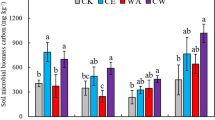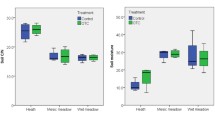Abstract
Climatic warming is known to impact terrestrial ecosystem structure and functioning. The response of belowground fauna such as soil nematodes to climatic warming has received little attention, yet the fauna plays crucial roles in the nutrient decomposition and cycling processes. An in situ factorial experiment was conducted to examine the effects of warming on the soil nematode community in a desert steppe. Both moderate-long and severe-short warming treatments were established using a thermal infrared heating facility, along with an unheated control, from 2011 to 2015. The main results were as follows: (i) climatic warming significantly decreased the abundances of total nematodes, plant parasites, fungal-feeding nematodes, and nematodes with high values on the colonizer-persister scale, such as predators and omnivores; (ii) warming significantly decreased the generic richness, maturity index, plant-parasite index, modified maturity index, and structural index, while increased the basal index of the nematode community; (iii) the soil nutrition status was significantly associated with the changes in the composition of the nematode community; and (iv) the responses of the soil nematode community to climatic warming and the consequent drought depended on soil layers and growing seasons. These results indicate a promotion of a more acquisitive resource-use strategy, one in which soil nematodes and soil microbes together impose an adaptive coordination to accelerate soil nutrient cycling by influencing carbon and nitrogen decomposition under climatic change in the desert grassland. The findings suggest that climatic warming could alter ecosystem functioning by altering the soil nematode community in arid areas.



Similar content being viewed by others
References
A'Bear AD, Jones TH, Boddy L (2014) Potential impacts of climate change on interactions among saprotrophic cord-forming fungal mycelia and grazing soil invertebrates. Fungal Ecol 10:34–43
Bakonyi G, Nagy P (2000) Temperature- and moisture-induced changes in the structure of the nematode fauna of a semiarid grassland—patterns and mechanisms. Glob Chang Biol 6:696–707
Bakonyi G, Nagy P, Kovacs-Lang E, Kovacs E, Barabas S, Repasi V, Seres A (2007) Soil nematode community structure as affected by temperature and moisture in a temperate semiarid shrubland. Appl Soil Ecol 37:31–40
Blankinship JC, Niklaus PA, Hungate BA (2011) A meta-analysis of responses of soil biota to global change. Oecologia 165:553–565
Bongers T, Bongers M (1998) Functional diversity of nematodes. Appl Soil Ecol 10:239–251
Bongers T, Ferris H (1999) Nematode community structure as a bioindicator in environmental monitoring. Trends Ecol Evol 14:224–228
Cesarz S, Reich PB, Scheu S, Ruess L, Schaefer M, Eisenhauer N (2015) Nematode functional guilds, not trophic groups, reflect shifts in soil food webs and processes in response to interacting global change factors. Pedobiologia 58:23–32
Cesarz S, Ciobanu M, Wright AJ, Ebeling A, Vogel A, Weisser WW, Eisenhauer N (2017) Plant species richness sustains higher trophic levels of soil nematode communities after consecutive environmental perturbations. Oecologia 184:715–728
Chen D, Cheng J, Chu P, Hu S, Xie Y, Tuvshintogtokh I, Bai Y (2015) Regional-scale patterns of soil microbes and nematodes across grasslands on the Mongolian plateau: relationships with climate, soil, and plants. Ecography 38:622–631
Dai A (2013) Increasing drought under global warming in observations and models. Nat Clim Chang 3:52–58
De Long JR, Dorrepaal E, Kardol P, Nilsson M-C, Teuber LM, Wardle DA (2016) Contrasting responses of soil microbial and nematode communities to warming and plant functional group removal across a post-fire boreal forest successional gradient. Ecosystems 19:339–355
Ferris H, Bongers T, de Goede RGM (2001) A framework for soil food web diagnostics: extension of the nematode faunal analysis concept. Appl Soil Ecol 18:13–29
Ferris H, Venette RC, Lau SS (1996) Dynamics of nematode communities in tomatoes grown in conventional and organic farming systems, and their impact on soil fertility. Appl Soil Ecol 3:161–175
Ilieva-Makulec K, De Boeck HJ (2013) Changes in soil nematode community structure following warming and drought manipulations in a grassland mesocosm experiment. Pol J Ecol 61:157–163
IPCC (2014) Climate change 2014: synthesis report. Contribution of Working Groups I, II and III to the Fifth Assessment Report of the Intergovernmental Panel on Climate Change [Core Writing Team, Pachauri RK, Meyer LA (eds.)]. IPCC, Geneva, Switzerland pp. 151
Kang L, Han XG, Zhang ZB, Sun OJ (2007) Grassland ecosystems in China: review of current knowledge and research advancement. Philos Trans R Soc B 362:997–1008
Kardol P, Cregger MA, Campany CE, Classen AT (2010) Soil ecosystem functioning under climate change: plant species and community effects. Ecology 91:767–781
Kostenko O, van de Voorde TFJ, Mulder PPJ, van der Putten WH, Bezemer TM (2012) Legacy effects of aboveground-belowground interactions. Ecol Lett 15:813–821
Lu M, Zhou XH, Yang Q, Li H, Luo YQ, Fang CM, Chen JK, Yang X, Li B (2013) Responses of ecosystem carbon cycle to experimental warming: a meta-analysis. Ecology 94:726–738
Lu XM, Siemann E, Wei H, Shao X, Ding J et al (2015) Effects of warming and nitrogen on above- and below-ground herbivory of an exotic invasive plant and its native congener. Biol Invasions 17:2881–2892
Ma Z, Liu H, Mi Z, Zhang Z, Wang Y, Xu W, Jiang L, He J (2017) Climate warming reduces the temporal stability of plant community biomass production. Nat Commun 8:15378. https://doi.org/10.1038/ncomms15378
Mayor JR, Sanders NJ, Classen AT, Bardgett RD, Clément JC, Fajardo A et al (2017) Elevation alters ecosystem properties across temperate treelines globally. Nature 542:91–95
Mueller KE, Blumenthal DM, Carrillo Y, Cesarz S, Ciobanu M, Hines J et al (2016a) Elevated CO2 and warming shift the functional composition of soil nematode communities in a semiarid grassland. Soil Biol Biochem 103:46–51
Mueller KE, Blumenthal DM, Pendall E, Carrillo Y, Dijkstra FA, Williams DG, Follett RF, Morgan JA (2016b) Impacts of warming and elevated CO2 on a semi-arid grassland are non-additive, shift with precipitation, and reverse over time. Ecol Lett 19:956–966
Nielsen UN, Ayres E, Wall DH, Li G, Bardgett RD, Wu TH, Garey JR (2014) Global-scale patterns of assemblage structure of soil nematodes in relation to climate and ecosystem properties. Glob Ecol Biogeogr 23:968–978
Ruess L, Michelsen A, Schmidt IK, Jonasson S (1999) Simulated climate change affecting microorganisms, nematode density and biodiversity in subarctic soils. Plant Soil 212:63–73
Simmons BL, Wall DH, Adams BJ, Ayres E, Barrett JE, Virginia RA (2009) Long-term experimental warming reduces soil nematode populations in the McMurdo Dry Valleys, Antarctica. Soil Biol Biochem 41:2052–2060
Song D, Pan K, Tariq A, Sun F, Li Z, Sun X et al (2017) Large-scale patterns of distribution and diversity of terrestrial nematodes. Appl Soil Ecol 114:161–169
Stevnbak K, Maraldo K, Georgieva S, Bjornlund L, Beier C, Schmidt IK, Christensen S (2012) Suppression of soil decomposers and promotion of long-lived, root herbivorous nematodes by climate change. Eur J Soil Biol 52:1–7
Thakur MP, Reich PB, Fisichelli NA, Stefanski A, Cesarz S, Dobies T et al (2014) Nematode community shifts in response to experimental warming and canopy conditions are associated with plant community changes in the temperate-boreal forest ecotone. Oecologia 175:713–723
Thakur MP, Tilman D, Purschke O, Ciobanu M, Cowles J, Isbell F et al (2017) Climate warming promotes species diversity, but with greater taxonomic redundancy, in complex environments. Sci Adv 3(7). https://doi.org/10.1126/sciadv.1700866
Tietjen B, Schlaepfer DR, Bradford JB, Lauenroth WK, Hall SA, Duniway MC et al (2017) Climate change-induced vegetation shifts lead to more ecological droughts despite projected rainfall increases in many global temperate drylands. Glob Chang Biol 23:2743–2754
Vandegehuchte ML, Sylvain ZA, Reichmann LG, Tomasel CMD, Nielsen UN, Wall DH, Sala OE (2015) Responses of a desert nematode community to changes in water availability. Ecosphere 6:44. https://doi.org/10.1890/ES14-00319.1
Veen GF, De Long JR, Kardol P, Sundqvist MK, Snoek LB, Wardle DA (2017) Coordinated responses of soil communities to elevation in three subarctic vegetation types. Oikos 126:1586–1599
Viglierchio DR, Schmitt RV (1983) On the methodology of nematode extraction from field samples: Biermann funnel modifications. J Nematol 15:438–444
Wardle DA, Bardgett RD, Klironomos JN, Setälä H, Van Der Putten WH, Wall DH (2004) Ecological linkages between aboveground and belowground biota. Science 304:1629–1633
Wardle DA, Gundale MJ, Jäderlund A, Nilsson MC (2013) Decoupled long-term effects of nutrient enrichment on aboveground and belowground properties in subalpine tundra. Ecology 94:904–919
Wu ZT, Dijkstra P, Koch GW, Penuelas J, Hungate BA (2011) Responses of terrestrial ecosystems to temperature and precipitation change:a meta-analysis of experimental manipulation. Glob Chang Biol 17:927–942
Xu ZZ, Hou YH, Zhang LH, Liu T, Zhou GS (2016) Ecosystem responses to warming and watering in typical and desert steppes. Sci Rep 6:34801. https://doi.org/10.1038/srep34801
Xu ZZ, Shimizu H, Ito S, Yagasaki Y, Zou CJ, Zhou GS, Zheng YR (2014) Effects of elevated CO2, warming and precipitation change on plant growth, photosynthesis and peroxidation in dominant species from North China grassland. Planta 239:421–435
Yeates GW, Bongers T, Degoede RGM, Freckman DW, Georgieva SS (1993) Feeding-habits in soil nematode families and genera—an outline for soil ecologists. J Nematol 25:315–331
Yeates GW (2003) Nematodes as soil indicators: functional and biodiversity aspects. Biol Fertil Soils 37:199–210
Yu HY, Ma QH, Liu XD, Xu ZZ, Zhou GS (2018) Short- and long-term warming alters soil microbial community and relates to soil traits. Appl Soil Ecol. https://doi.org/10.1016/j.apsoil.2018.07.006
Acknowledgments
We greatly thank Feng Zhang, Wenju Liang; Cunzheng Wei, Guofang Liu, He Song, Yibo Li, and Yu Zhu for the help during the study.
Funding
The study was funded by the National Natural Science Foundation of China (31661143028, 31170456) and China Special Fund for Meteorological Research in the Public Interest (Major projects) (GYHY201506001–3).
Author information
Authors and Affiliations
Contributions
Zhenzhu Xu and Guagnsheng Zhou deceived and designed the study; Quanhui Ma, Hongying Yu, Xiaodi Liu and Yaohui Shi conducted the field work. Zhenzhu Xu, Quanhui Ma and Hongying Yu performed the data analyses. All authors wrote and proofread the manuscript.
Corresponding authors
Rights and permissions
About this article
Cite this article
Ma, Q., Yu, H., Liu, X. et al. Climatic warming shifts the soil nematode community in a desert steppe. Climatic Change 150, 243–258 (2018). https://doi.org/10.1007/s10584-018-2277-0
Received:
Accepted:
Published:
Issue Date:
DOI: https://doi.org/10.1007/s10584-018-2277-0




